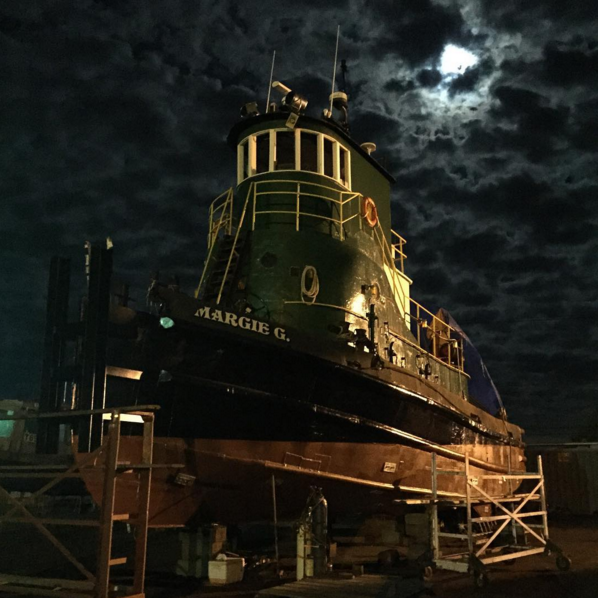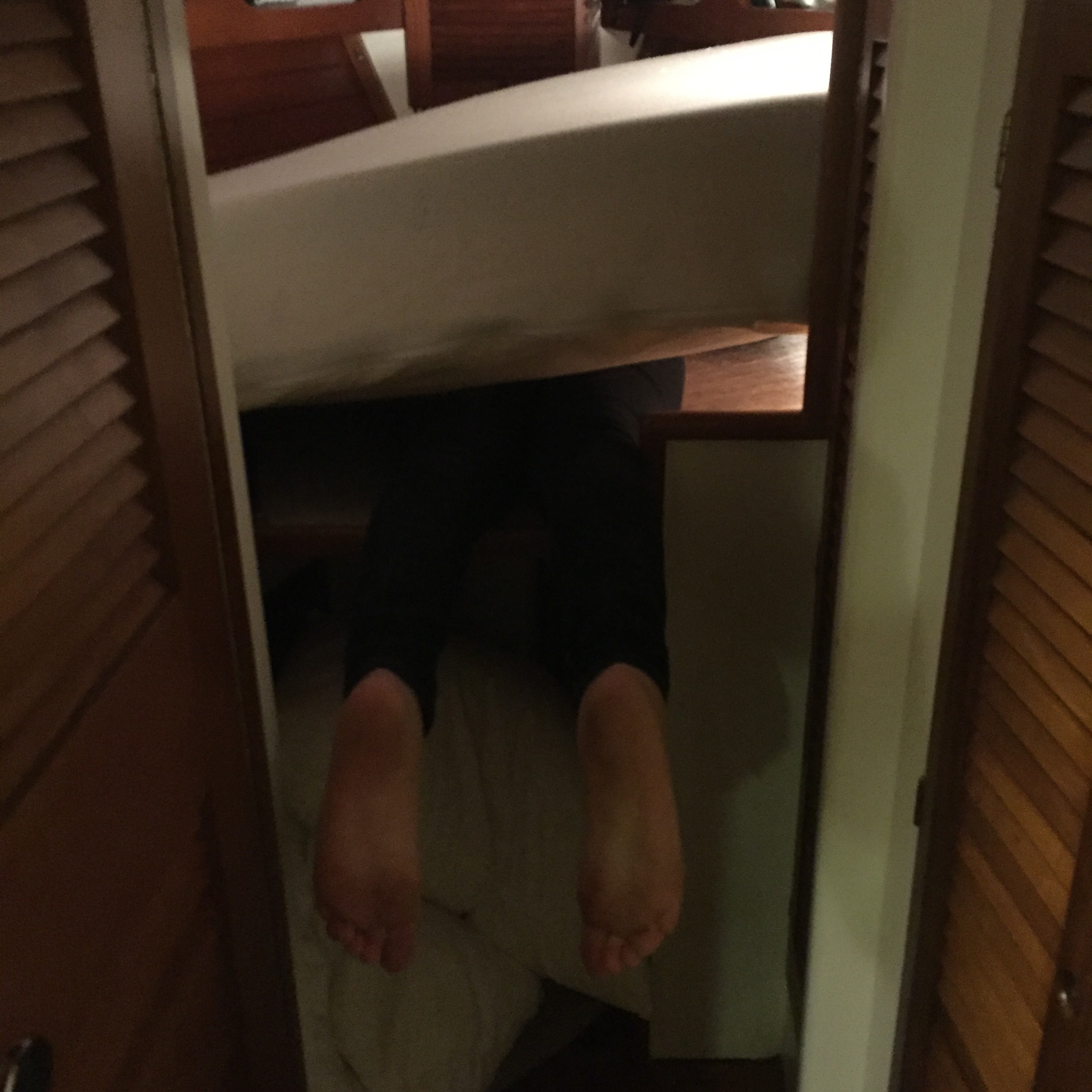If you're confused about how we live on a boat through a proper snowy winter, you're not the only one. It's the single-most asked question I get as a liveaboard, with some variations on the theme, including how we heat the boat (space heaters), whether we're at risk of floating away when it storms (no), and if we have to pee or shower outside (oh hell no, we're not heathens.)
Still, when you're land-bound, it's hard to imagine the logistics of wintering aboard. When we first started thinking about buying a boat, I picked up The Essentials of Living Aboard A Boat by Mark Nicholas. From our sunny front Porch in L.A., I read about the perils of winter boat living -- the damp, the mold, how all his suits were wrinkled on one side from condensation in the closet. How you had to build a bubble around your boat and fill your engine with anti-freeze so it wouldn't crack.
I have a very specific memory of setting the book down, looking at Jon and saying out loud, "let's never move to the East Coast." We were in strong agreement on that.
Months later, in a card Jon gave to me just a few moments before he proposed to me on a beach in front of our boat, he wrote: "I love our life, let's never live in the snow."
Yet here we are. And to be honest, it's not as bad as I thought it would be. Well, the snow is. But it's been a few chilly months now and I still love #boatlife.
So, let me paint a picture of what life is like aboard in (this relatively mild) winter. Let me know if you think I'm as crazy as I once thought Mark Nicholas was.
Where do boats... erm... live?
First, let's clarify something a lot of non-boat people have misconceptions about. Boats can be anchored, moored or tied to a dock. Unless you're cruising, it's a good chance that if you're living aboard, you're at a dock, in a marina. We are. We don't dinghy into shore every day. We won't get hit by a ferry. We have electricity.
Okay, now that that's out of the way. If you are at a dock, in a marina, there are two ways to store a boat in a marina in winter -- "on the hard", which means out of the water and in the dockyard, propped up by stilts, or by "wet storage", which means keeping the boat in the water the whole winter.
Most liveaboards keep their boats in the water, including us. When you're on the hard, it's more difficult to access electricity, any water you use dumps directly to the blacktop below you and you have to climb a ladder about 10 feet in and out of your home. So it's definitely preferable to stay in the water.
What about ice?
Our boat is protected by bubblers, little underwater fountains that circulate the water to prevent ice from forming against the hull. That's how we don't get stuck in ice all winter.
Also, water is shut down on the docks because the pipes would otherwise freeze. So we have to use long hoses from pumps on land to fill our tanks. Which is, yes, a total pain. When people forget to empty the water out of the hoses, the water freezes, and you can be stuck without water until the sun warms things up again, or if you're in a hurry, you'll need to resort to some fairly undignified activities to defrost your hoses.
On our boat, we have sinks that operate by foot-pump and no hot water heater. So the fresh water we do use is chil-ly. Unsurprisingly those arctic blasts while washing hands or our faces definitely helps with our water conservation of the 30 or so gallons we have aboard at a time. Brrr.
How do you heat a boat?
Our boat has been up to Alaska and back down to the tip of Mexico, so it's really well insulated. But it no longer has a built-in heat source. So this winter, we have three electric heaters that we're loving -- a mini fireplace that I've written about before, a baby radiator-style heater that's safer to leave on during the day for our dog, and a West Marine heater that we can leave on when we're on trips that will automatically turn on if the boat's internal temperature drops below freezing. They're all small and easily stowed. We rotate them so that no one heater runs for more than a few hours at a time, to prevent risk of overheating. But since our boat isn't going anywhere this winter, we haven't invested in any kind of heating that would be usable offshore.
We also have an electric blanket that we're obsessed with that takes the edge off getting into chilly sheets in the v-berth, a.k.a. our boat bedroom.
Why does the boat look like a giant bubble?
The best thing we did this winter was shrink-wrap the boat. Having some version of boat wrapping is a very good idea for cold weather boat lovers, whether your boat is in the water or not. Wrapping it protects the boat from moisture damage and keeps it warmer inside.
Not everyone wraps their boats, but it can expose boats, especially unattended ones, to more dangers. For example, a friend of a friend left their boat for the season, unwrapped. The weight of the snow caused a leak that then froze, melted and refroze, ruining ceiling and floor inside.
If your boat is out of water, the wrapping is usually white and opaque, and looks a little marshmallow-like. Some people buy specially fitted canvas covers that they can use year after year. If you're living aboard, the plastic is clear, and looks like this:
Longterm liveaboards often forego shrinkwrapping and instead invest in nicer cockpit enclosures that they can use for storage or extra living space in the dead of winter. That does mean, though, that you end up having to shovel your deck after a big snowstorm. All due respect to the cash saved, I say a thousand nopes to that.
And on a nice sunny day, the deck of our boat heats up like a greenhouse, allowing us to sit barefoot and in t-shirts "outside" while it's freezing just on the other side of the zipper.
Are we always warm and dry?
Yes and no. For one, it's definitely not like camping. But sometimes, after a long day at work, I find my pajamas or sweater are a little... damp.
The Scallywag has kept us cozy, but much like a house with poor insulation, the temperature difference between the inside and outside on boats can cause condensation to form. Which means we have to have great circulation in the boat and plenty of dry heat to prevent our stuff from getting damp or growing mold. That's as gross as it sounds. That's also why even people who have boats with showers don't shower in the winter -- you just go through too much water and create too much moisture to make it worth it.
We haven't had too much of a problem yet with this, because almost all the "closed" spaces on our boat have natural circulation in some way. The backs of our settees, for example, are woven out of rattan, which means air can pass through easily.
We did have a close call with our foam mattress, which tends to get wet on the bottom during particularly cold nights. We've fixed that with a layer of Hypervent, which looks like a rug made out of stiff dish-scrubbing plastic, and allows air to circulate between two layers (like wood and a mattress) to prevent condensation. Basically, the more we've learned about how to prevent condensation from forming, the dryer we've been. The wrapping seriously helps with this too, as it essentially creates a layer of insulation with the air pocket between the boat and the plastic covering.
Don't people, like, slip and fall off the dock and die?
For some reason this is on a lot of people's minds, including my mother's (hi mom!) who yells "Natalie Wood!" at regular intervals when I mention walking our dog at night or hanging out on the boat alone. But so far it's been a nonissue.
We haven't had much snow this winter, so the docks haven't been icy at all. Because I'm neurotic, I keep a whistle in my coat, just in case. But so far, it hasn't even come close to being a problem for us, and I imagine you'd have to be pretty tired/drunk/distracted to fall in. However, our marina is religious about keeping ice off the docks, whereas less well-maintained marinas might be dicier, similar to having a bad landlord who doesn't salt your sidewalk.
What sucks the most about living this way?
There are fewer things of note than you might imagine. And there's a different low for everyone when it comes to wintering aboard.
One woman I talked to mentioned that she misses the extra space of the cockpit -- because when it isn't a beautiful day out you lose what's essentially an extra room in your home.
For me, it's that I have to layer on a coat and boots, then walk through a cold wind or snow to have a hot morning shower. And that our water on the boat, which isn't heated, is icy when I wash my hands or dishes.
When I asked Jon, he said he still hasn't gotten over taco-ing the foam mattress in the narrowest part of the boat so that we could layer hypervent under it.
And now that I think about it, I don't think I've gotten over it either. Or rather, gotten over getting stuck under it. #boatlife.








